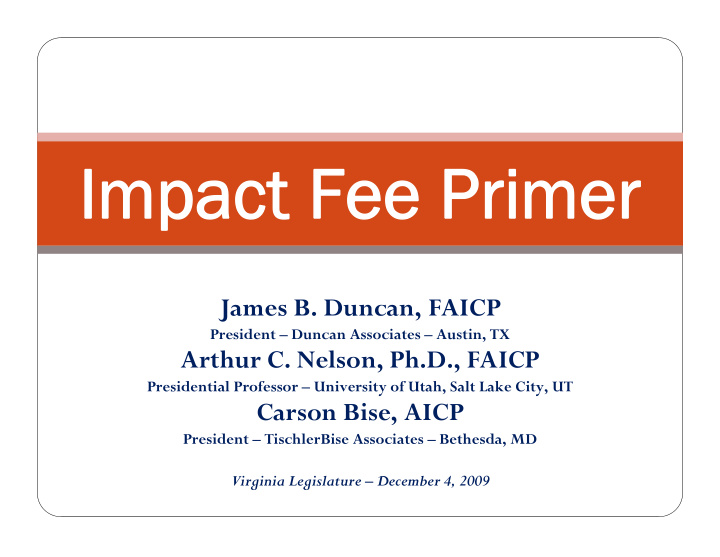



Impact Fee Primer Impact Fee Primer James B. Duncan, FAICP President – Duncan Associates – Austin, TX Arthur C. Nelson, Ph.D., FAICP Presidential Professor – University of Utah, Salt Lake City, UT Carson Bise, AICP President – TischlerBise Associates – Bethesda, MD Virginia Legislature – December 4, 2009
James B. Duncan, FAICP James B. Duncan, FAICP � President of national consulting firm, Duncan Associates � Drafted development codes for over 300 clients in 40 states � Drafted codes for numerous Virginia cities and counties � Drafted impact fee studies for over 100 clients in 30 states � Created nation’s 1st online resource: www.impactfees.com � Managed nation’s 1st multi-facility impact fee system � Co-authored nation’s 1st state impact fee enabling act � Co-authored “Growth Management Principles and Practices” � Past national president of American Planning Association
Evolution of Impact Fees Evolution of Impact Fees � 1970s – Era of Frustration � Rapid urbanization � Anti-tax revolution � 1980s – Era of Acceleration � Declining State and Federal assistance “Reaganomics” (Public-Private Partnerships) � � 1990s – Era of Maturation � “Smart growth”-oriented impact fees Increased state enabling legislation � � 2000s – Era of Frustration II � Skyrocketing infrastructure costs and fees � Roller coaster real estate markets
“The Perfect Impact Fee Act” “The Perfect Impact Fee Act” � The “Rational Nexus” Test � Need (plans and projections) � Benefit (CIPs and service areas) � Fair Share (proportionality) Fair Share Need Benefit
“The Perfect Impact Fee Act” “The Perfect Impact Fee Act” � Substantive issues � Eligible facilities (Be permissive, not prohibitive) � Levels of service (Omit “sins of the past”) � Crediting (No double charging) � Earmarking (Spend wisely)
“The Perfect Impact Fee Act” “The Perfect Impact Fee Act” � Procedural issues � Stakeholder involvement � Collections and refunds � Timing: Phase-ins and updates � Waivers and exemptions
Recommend
More recommend